December 24th, 2021 · Comments Off on Children’s Card Games (252)
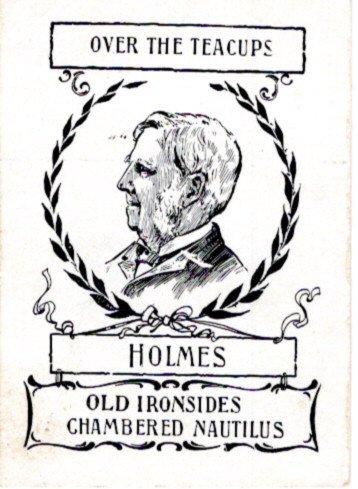
Parker Brothers published several editions of “Authors” over the years. This one is a “nickel edition”: undated, but probably from around 1900. It’s a small deck, with only 21 cards, and a simple design in black and white. In addition to Oliver Wendell Holmes, shown for some reason in profile, the pantheon contains Tennyson, Cooper, Howells, Longfellow, Scott, and Hawthorne. The box shows a pleasant gentleman catching up on his reading, although he does seem to be holding the book at an odd angle.
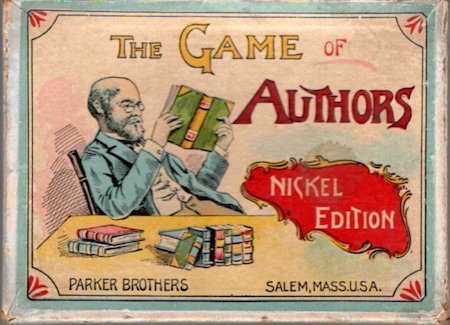
(Posted by Doug Skinner)
Tags: Card Games
December 14th, 2021 · Comments Off on Shorten the Classics
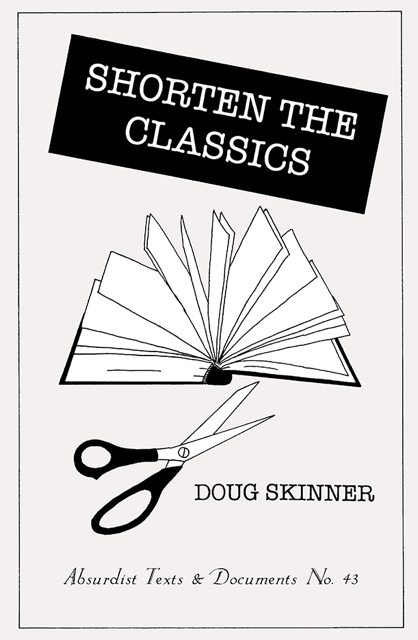
Shorten the Classics is now available from Black Scat Books! This book reduces 52 great works of literature to one cartoon page apiece: not by summarizing them, but by cutting them off early. See what happens when Helen rejects Paris, the acorn misses Chicken Little, Adam and Eve eat the serpent, Leopold Bloom sleeps in, and Samoan women tell Margaret Mead to mind her own business. Tragedies are prevented, lives are saved, and the world becomes a better place. And you can find it on Amazon.
(Posted by Doug Skinner)
Tags: Books · Cartoons
November 16th, 2021 · Comments Off on Black Scat Review 23

The 23rd issue of Black Scat Review is now available! It’s devoted to “wordplay,” and includes several pages of Doug Skinner: my translations of two poems by Raymond Queneau (depicted on the cover) and four pages of my upcoming comic book Shorten the Classics. Also on board are the stellar crew of Mark Axelrod, Tom Barrett, Kevin Brown, Norman Conquest, Brian Coughlan, John Crouse, S. C. Delaney, Paul Forrestal, Ryan Forsythe, Eckhard Gerdes, Penelope Gerdes, Joseph Harms, Amy Kurman, Opal Louis Nations, Angelo Pastormerlo, Steve Patterson, Derek Pell, Agnès Potier, Paul Rosheim, Gerard Sarnat, Carla M. Wilson, and D. Harlan Wilson. You can find it on Amazon. When you find it, buy a copy!
(Posted by Doug Skinner)
Tags: Cartoons · Literature
October 29th, 2021 · Comments Off on Ventriloquism 45s
Both ventriloquism and 45 rpm records were long staples or entertainment; both are less popular these days. 45 rpm records by ventriloquists, however, were always somewhat of a rarity. Here are seven examples of this curious genre. (Please click on them to enlarge them).
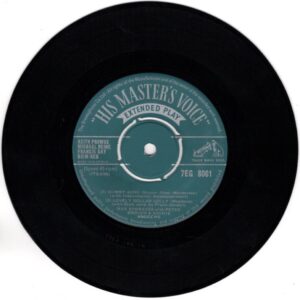
Peter Brough and his dummy Archie Andrews starred in the BBC Radio show Educating Archie, from 1950 to 1960. It’s remembered now mostly for its supporting cast, which included such veterans as Harry Secombe, Julie Andrews, and Benny Hill. Max Bygraves played Archie’s tutor; these two songs, “Dummy Song” and “Lovely Dollar Lolly,” were taken from the show. The B side offers two solo numbers by Bygraves, “Cowpuncher’s Cantata” and “You’re a Pink Tooth Brush.”
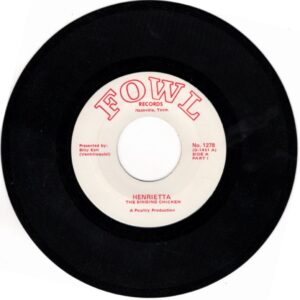
Billy Earl, a ventriloquist in Nashville, released this single of a live performance with his chicken puppet, Henrietta. Henrietta sings the mildly bawdy “Chicken Song” to an enthusiastic crowd.
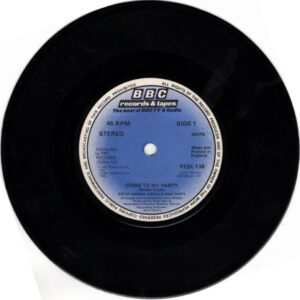
Keith Harris had several TV series on the BBC, including The Keith Harris Show in the ’80s. This record features his characters Orville, a green duck, and Dippy Dragonaurus. Orville is a sort of falsetto child, and Dippy is firmly in the Goofy-Mortimer Snerd-Beaky Buzzard-Eccles line of cheerful idiots. The A side is “Come to My Party,” and the B side is “Thank You for Telling Me ‘Bout Christmas.”
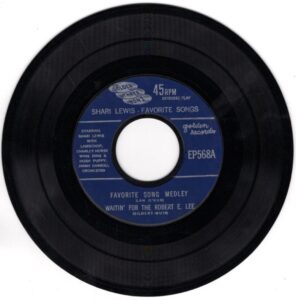
Shari Lewis had a long career in all fields of show business. This record showcases four off her puppets: Lambchop, Charley Horse, Wing Ding, and Hush Puppy. The first side includes “Favorite Song Medley” and “Waiting’ for the Robert E. Lee,” and the second “Back in Your Own Backyard” and “Let a Smile Be Your Umbrella.”
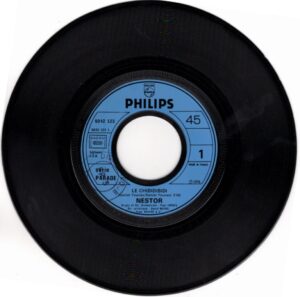
The French ventriloquist David Michel performed for decades with a penguin puppet named Nestor. He’s now 76, and apparently still working. This record has two songs, “Le Chibidibidi” and “Une Petite Fille, un Pingouin.”
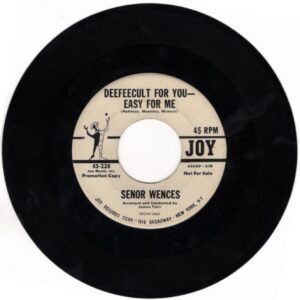
Señor Wences also had a long career, including numerous TV appearances and commercials. He continued performing up until his death at 103. This rec0rd, from 1959, includes songs based on two of his catchphrases, “Deefeecult for You–Easy for Me” and “‘S-All Right?–‘S-All Right!”
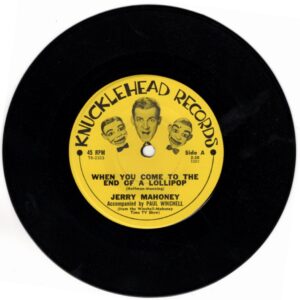
And lastly, Paul Winchell, who had great success as a ventriloquist in the ’50s, and later turned to doing voice work for cartoons. He was also an acupuncturist, and held several patents, including one for an artificial heart. This record, on his own label, features both his dummies: Jerry Mahoney sings “When You Come to the End of a Lollipop,” and Knucklehead Smiff sings “Run, Little Rabbit.”
(Posted by Doug Skinner)
Tags: Ancient History
September 29th, 2021 · Comments Off on Children’s Card Games (251)
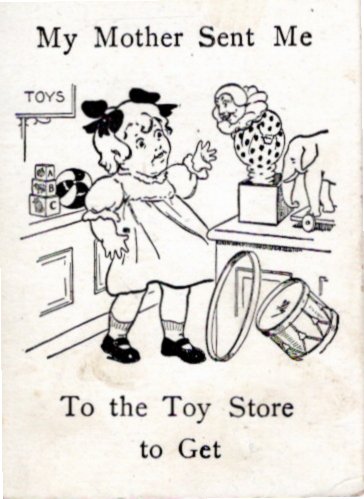
“My Mother Sent Me to the Grocery Store” was published by Parker Brothers; it’s undated, but a search reveals that it’s probably from around 1902. The rules are simple: each player draws from a stack of cards showing children in various stores (grocery store, toy store, florist, baker, etc.). The player then draws from another stack of slips, each with the name of an object.
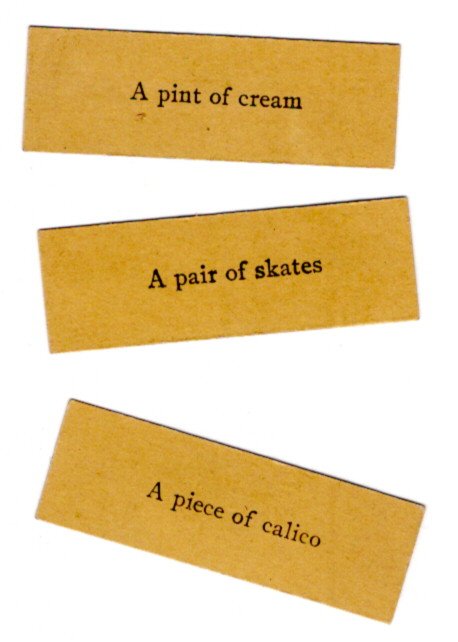
If the object can be found in the store, the player keeps the slip. Whoever has the most slips at the end wins.
(Posted by Doug Skinner)
Tags: Card Games
September 14th, 2021 · Comments Off on Bulletin (44)
My translation of Charles Cros’s Principles of Cerebral Mechanics has garnered a nice review from Tom Bowden, over here. No doubt you’ll want to read it carefully and then share it with all your friends.
My compilation of anomalous music, Music From Elsewhere, has been delayed until next year, since Strange Attractor Press is so busy. I suppose that gives me a chance to fuss over it some more.
My next book for Black Scat Books will be Shorten the Classics, a comic book in which 52 classic works of literature are reduced to four panels. I’ve been enjoying aborting so many tragedies: Narcissus realizes he’s not that handsome, Jean Valjean gets a job, Dante asks directions, Helen rebuffs Paris. I hope to finish it in October.
Also coming up from Black Scat is my next translation of Alphonse Allais, Amours, délices, et orgues (Loves, Delights, and Organs). The title is familiar to all French schoolchildren, those being the three words that are masculine in the singular and feminine in the plural. This one is slated for December.
My album of songs, It All Went Pfft, is mostly done, but I want to redo a couple of numbers. There’s always something.
And lastly, I continue to teach ukulele classes over Zoom, through the Jalopy Theatre. A fresh round starts next week.
(Posted by Doug Skinner)
Tags: Bulletins
August 16th, 2021 · Comments Off on Principles of Cerebral Mechanics
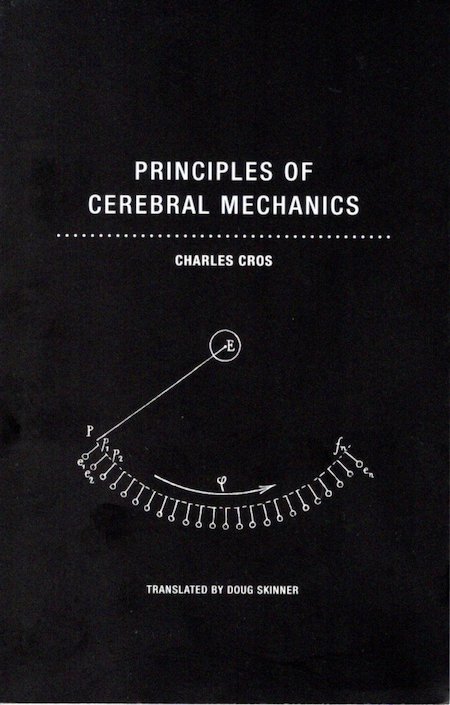
Principles of Cerebral Mechanics is now available from Wakefield Press! This is my third translation of Charles Cros (these are the others). Here’s how Wakefield describes it:
Though lesser known among the scientific writings of Charles Cros, Principles of Cerebral Mechanics is a visionary work that further establishes the author’s standing as the inventeur maudit of his time. First presented to the Academy of Sciences in 1872, it wasn’t published until 1879, and then only in fragmentary form before the journal in which it appeared folded, and what Cros claimed to be the only manuscript copy had been thrown into a fire by his mistress during a lover’s quarrel.
Setting out to understand the mechanics of perception, the organs of which were too small and inaccessible to be studied directly at the time, Cros attempted to reverse engineer the sensory apparatus. Whereas his inventions in the realms of audio recording and color photography focused on technology for the senses, with this ambitious essay Cros turned to conceptualizing the technology of the senses themselves: rather than the transmission of color to the retina, here he tried to conceive of how color was transmitted from the retina to the brain. By approaching the human brain as a “mechanism of registration” and conceptually dissecting it into the gears of an image recorder, Cros’s essay can be set alongside the groundbreaking work of such revolutionary figures who transformed modern vision as Étienne-Jules Marey and Eadweard Muybridge.
Charles Cros (1842–1888) was as much Renaissance man as he was poète maudit. A bohemian poet who drank with Verlaine and at one point provided housing to Rimbaud, he also developed the comic monologue as a theatrical genre, and invented both the phonograph (which he named the “paléophone”) and color photography (though he failed to patent either before Thomas Edison or Louis Ducos du Hauron), among other such inventions as a non-metallic battery and a musical stenographer. “The freshness of his intelligence was such that no object of desire seemed utopian to him a priori,” André Breton wrote of him, adding: “The pure playfulness of certain wholly whimsical portions of Cros’s work should not obscure the fact that at the center of some of his most beautiful poems a revolver is leveled straight at us.”
(Posted by Doug Skinner)
Tags: Literature
July 19th, 2021 · Comments Off on Black Scat Review 22
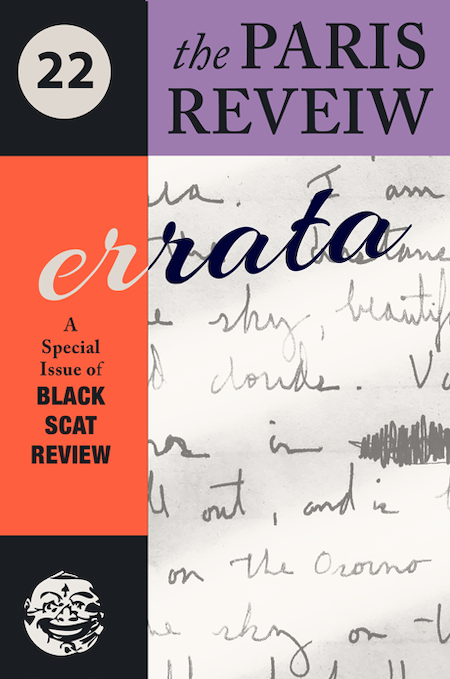
The 22nd issue of Black Scat Review is now available! This is the “Errata” issue, and contains my contributions “Shakespeare Misspelled” and “Typos on Title Pages.” It also features texts, comics, collages, and drawings by my lively colleagues Terri Carrion, Norman Conquest, Caroline Crépiat, Farewell Debut, S. C. Delaney, Jean-Pierre Duffour, Errorbiblioteca, Paul Forristal, Ryan Forsythe, Eckhard Gerdes, Rhys Hughes, Amy Kurman, Alex McKeown, Claudio Parentela, Angelo Pastormerlo, Agnès Potier, Collin J. Rae, C. R. Resetarits, Jason E. Rolfe, Paul Rosheim, Kristine Snodgrass, Linda Klieger Stillman, Corinne Taunay, Michel Vachey, and Carla M. Wilson, and is edited and designed by Norman Conquest. It’s available on Amazon from Black Scat Books. More mistakes for your money!
(Posted by Doug Skinner)
Tags: Literature
June 30th, 2021 · Comments Off on Le Chat Noir Exposed
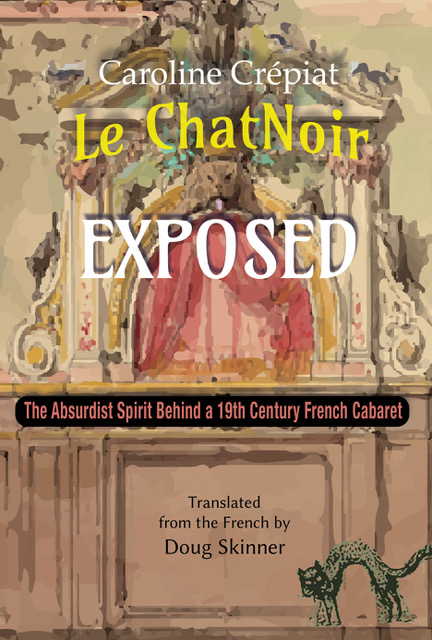
Le Chat Noir Exposed is now available from Black Scat Books!
This extraordinary work of scholarship exposes the liveliest fin-de-siècle bohemian cabaret and paper in Paris. Le Chat Noir was a playground for painters, writers, poets, pranksters, and musicians, all gleefully demolishing the standards of art and good taste. Caroline Crépiat examines such eccentric personalities as Paul Verlaine, Alphonse Allais, Marie Krysinska, Maurice Mac-Nab, and Charles Cros, and analyzes their treatment of money, women, translation, humor, sex, disease, and scatology, with generous samplings of the original texts. A masterful look at a rich and colorful legend of the avant-garde! Translated by Doug Skinner and available from Black Scat Books!
(Posted by Doug Skinner)
Tags: Books
June 22nd, 2021 · Comments Off on Memorable Magazines (20): The Children’s Hour
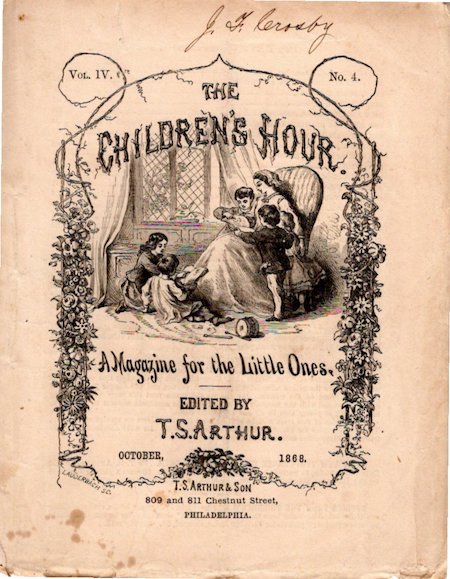
The Children’s Hour was a monthly magazine edited by Timothy Shay Arthur. Arthur was a fervently industrious writer in the middle of the 19th century, turning out dozens of novels preaching morality and temperance, as well as publishing some 14 magazines. He’s best remembered today for his novel Ten Nights in a Bar-Room and What I Saw There, which had a long life in a theatrical version.
The Children’s Hour was published from 1867 to 1874, and was meant for children from six to twelve. Each issue contained 32 pages, filled with short stories, poems, and serials. Arthur tended to feature his own voluminous output.
The October 1868 issue opens with “The Sketch-Book,” by Mrs. Mary Latham Clark, in which little Gertie learns that her drawing lessons are not in fact a waste of time. Other stories concern the virtues of patience and altruism, a dog who leads another dog to the vet, a boy who learns the value of obedience, and a conversation between a mother and child about how God feeds the birds. Verses include an evening hymn, a homily on kindness, and a poem praising the industry of bees. Arthur himself contributes a story in which a mother tells her daughter that angels send bad to punish sinners, prompting the frightened child to confess that she took a slice of cake from the pantry, and that her name is now blackened in the angelic record.

As the Christian Standard put it, in a blurb on the back cover, “The moral and religious tone is pure, sweet and cheerful.” What a relief it must have been for children when writers like Lewis Carroll and Edward Lear started giving them something that wasn’t a sermon! One curiosity in this issue is Emerson’s poem “The Mountain and the Squirrel”–not its first appearance, but differing in some respects from later editions. Like the rest of the magazine, it’s meant to teach a lesson, but at least it’s written in a livelier style.
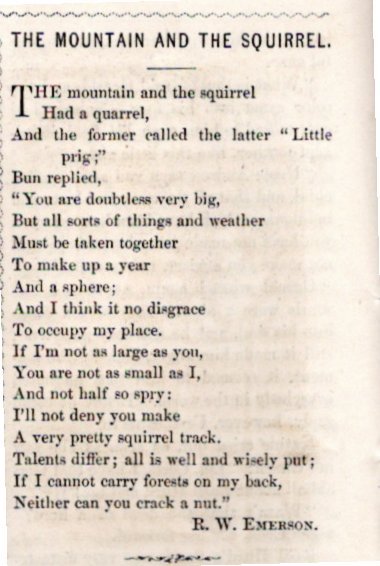
(Posted by Doug Skinner)
Tags: Ephemera · Literature



















